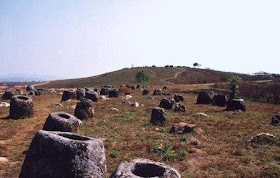The Plain of Jars: Mystery at the North East Laos

For the like of temples in Cambodia, Thailand, Indonesia and other South East Asia countries’, have had received numerous visits from both tourists and experts in the fields of History or Archaeology. But this Plain of Jars, which locates in the remote North East area of Laos PDR, still has many things hidden and yet, no one is able to reveal their reason of existence.
This site should be new to the audiences, and in extension, shall become their new and next destination in South East Asia region. The plain has many stories to tell, it has to be you to speak them out by yourselves. To reach this place, it is recommended to arrive in Phonsovan, a new capital of Xiang Khouang province. There you can commence your journey into the world of ancient properties.
Please take note that the area where the Plain of Jars situated, used to received massive bombing, which tells the fact that Laos is the world most bombing country in the world. Despite this, tourists wander there no for this reason, but to see what must be seen by their own eyes. The beauty of undecorated, not well-arranged and no pattern lay of numerous of old Jars stricken to the earth’s soil. Westerners would name this place as Asian “Stonehenge.”
There are total of more than 400 sites across the whole Plain of Jars that centers on the area of Xieng Khouang. They range from Khorat Plateau in Thailand in the south, through Laos and to North Cachar Hills in northern India. Archaeologists have found more similar burials in India. The jars appear to be laid in a linear path that was probably a trade route.
The jars are made of sedimentary rock, usually sandstone, but also granite, conglomerate or calcified coral. They are angular or round and some have disks that could be lids. They can weigh up to 14 short tons (13 metric tons) and range from 3 to 10 feet (1-3 meters) in height,
In fact, there has been some researches and study to the history of this plain. One major discovery is of French archaeologist Madelaine Colani, who supposed that these jars are of funeral purposes, which ancient people use to stores the cremate remains. Even this theory is not opened to public yet, but recent discovery has shown plentiful support to her verdicts.
To imagine the Plain of Jar in your mine, I would like to quote a paragraph from the novel “The Plain of Jars”:
"The Plain of Jars presented a striking contrast to the rugged terrain Dorothy had traveled through to get there. An elevated plateau of friable, chalky limestone, washed out from the surrounding harder rocks by a million years of rain, it offered a welcome relief to the harsh land around it. The Laotians call the place Tung Hai Hin, while the Vietnamese still refer to it as the Tran Ninh Plateau. From above, it is an abruptly conspicuous feature, occupying an area of one thousand square kilometers, sitting more than three thousand feet above sea level. The Plain, contrary to its name, is not monotonously flat, but undulating - a rolling meadowlands with softly curved, breast-like hills, changing colors with the seasons, remaining a vivid green after the monsoon rains, until the sun sears it pale yellow during the hot, dry, tropical summer. Long broad valleys of rich, well-watered soil separate scattered masses of solitary mountains, which stand like lonely leviathans, stark and lost in the midst of their puny surroundings, inexplicably cut off from the herd of great ranges beyond."

No comments:
Post a Comment